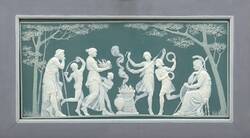Further Media
The two rectangular panels feature themes from ancient Greek mythology: the wedding procession of Amor and Psyche and a festive sacrificial scene. The scenes are decoratively framed by trees with delicate foliage. Such mythological motifs and the relief work reminiscent of antique cameos, show their reference to classicism.
Owing to the tower mark and numbers stamped on the back, the two reliefs can be identified as works by the company Villeroy & Boch based in Mettlach in the Saarland, executed in 1902. The artist Jean-Baptiste Stahl (Johann Baptist Stahl, 1869-1932) from Alsace was responsible for the designs; his abbreviation ST can be seen on the plates. As master modeller at Villeroy & Boch, he was also entrusted with the development of new techniques such as the phanolith process used here. The term phanolith was derived from the ancient Greek words phanein (to shine through) and lithos (stone). It was one of the manufactory's most successful inventions: With the phanolith-technique Stahl won the Grand Prize at the 1900 World Exhibition in Paris. In this process, the white sections formed in a relief model are applied to the coloured, unfired stoneware body. Subsequently, the motifs created in high relief are often built up by applying several layers of white slip or they were incised, whereby a three-dimensional, painterly depth effect was achieved. The Jasperware of the English manufacturer Josiah Wedgwood as well as the Pâte sur Pâte technique of the French manufacturer Sèvres, served as models for this elaborate decorative process.
The mounted reliefs show a highly detailed, delicate relief image of the figures in brilliant white, while darker areas of the relief image give the impression of shadows. This unique combination of sculptural relief image and painterly translucent background image brought Stahl's work great renown in its time. The present copies are an impressive testimony to this refined technique.
Text: Sojin Baik
